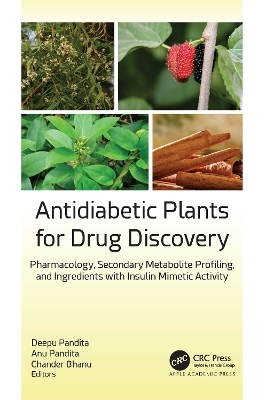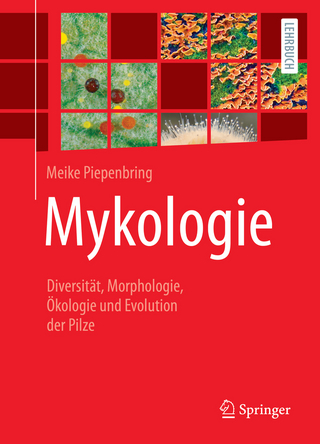
Antidiabetic Plants for Drug Discovery
Apple Academic Press Inc. (Verlag)
978-1-77491-006-1 (ISBN)
This volume takes an in-depth look at the potential pharmacological applications of 11 important antidiabetic plants, examining their antihyperglycemic, hypoglycemic, and anti-lipidemic properties along with current genome editing research perspectives.
Plant natural products, or phytoconstituents, are promising candidates for antidiabetic pharmacological actions. The phytoconstituents, such as fl avonoids, terpenoids, saponins, carotenoids, alkaloids and glycosides, play vital roles in the current and future potent antidiabetic drug development programs
Each chapter reviews a particular plant with antidiabetic properties, explaining the therapeutic aspects, its active antidiabetic compounds, and relevant genome editing technology. The specific plants discussed include Azadirachta indica (commonly known as neem, nimtree or Indian lilac), Gymnema sylvestre (commonly called gymnema, Australian cowplant, and Periploca of the woods), Syzygium cumini (commonly known as Malabar plum, Java plum, black plum, jamun or jambolana), Ceylon cinnamon (or true cinnamon, as opposed to cassia cinnamon), insulin plant (or Costus pictus), Trigonella foenum-graecum (better known as fenugreek), Mulberry, Nigella sativa L. (black caraway, also known as black cumin, nigella, kalojeera, kalonji or kalanji), Aegle marmelos (L.) (commonly known as bael (or bili or bhel), also Bengal quince, golden apple, Japanese bitter orange, stone apple or wood apple), Ficus benghalensis (the banyan, banyan fig and Indian banyan), and of course, garlic (Allium sativum).
Antidiabetic Plants for Drug Discovery: Pharmacology, Secondary Metabolite Profiling, and Ingredients with Insulin Mimetic Activity will serve as a valuable source of information for students, drug researchers, medical practitioners, diabetic patients, and many others in the effort to gain understand of how these plant drug molecules can help fight diabetes.
Deepu Pandita is a senior lecturer in the Government Department of School Education, Jammu, Union Territory of Jammu and Kashmir, India. Deepu Pandita has more than 17 years of teaching experience. She has done her Masters in Botany from the University of Kashmir, Jammu and Kashmir, India, and Master of Philosophy (MPhil) in Biotechnology from the University of Jammu, Jammu and Kashmir, India. Deepu Pandita has a number of international and national courses to her credit. She has qualified for fellowships such as JRF NET and SRF from the Council of Scientific & Industrial Research (CSIR), New Delhi, India; Biotechnology Fellowship from the Government Department of Science and Technology, Jammu & Kashmir, India; and IASC-INSA-NASI Summer Research Teacher Fellowship, India, from the Indian Academy of Sciences, Bengaluru, India. Deepu Pandita has presented her research work at both the national and international conferences and was awarded Best Oral Presentation Award in an International Conference on Biotechnology for Better Tomorrow. She has received the Avtar Krishan Award of Cytometry at the Indo-US Cytometry Workshop on Clinical Research, organized jointly by Punjab University, PGIMER Chandigarh, and the University of Miami, USA, and a Women Researcher Award and Research Excellence Award by two professional associations of India. Deepu Pandita is a life member of various scientific societies. Deepu Pandita acts as a reviewer (18 journals), associate editor, and editor of a number of international journals. She has published a number of editorials, reviews (1 in Cells with impact factor of 4.366), research articles, and 11 book chapters in prestigious journals like Springer, Elsevier, and CRC Press. Anu Pandita is a dietician at Vatsalya Clinic, Krishna Nagar, New Delhi, India. Previously she worked as a lecturer at the Bee Enn College of Nursing, Talab Tillo, Jammu, India, and as a dietician at the Ahinsa Dham Bhagwan Mahavir Charitable Health Centre, New Delhi, India. Anu Pandita did her MSC Internship and a course in the Dietetics Department of PGI, Chandigarh, India, and has done a case study at the Pediatric Gastroenterology Ward at Nehru Hospital PGI, Chandigarh, India, on a patient suffering from chronic liver disease. She has done a Certificate in Food & Nutrition as well. She has a number of trainings, refresher courses, and workshops to her credit. Anu Pandita is a life-time member of the Indian Dietetic Association and Indian Science Congress Association, Kolkata, India. Anu Pandita has presented her research work at both national and international conferences. Anu Pandita has published four book chapters with Springer and a number of reviews and research articles in various journals of national and international repute. Chander Bhanu is a senior consultant physician at the Vatsalya Clinic; at the Dr. Kailash Chander Jain Memorial Clinic; and at the Ahinsa Dham Bhagwan Mahavir Medical Center, all in New Delhi, India. Previously he was a neuro associate at the Institute of Brain and Spine; resident medical officer in at the Vidya Sagar Institute of Mental Health and Neurosciences) Hospital, New Delhi; a chief medical officer at Primus Hospital, where handled international cases from various embassies; and a medical officer in the Neurology and Neurosurgery Departments at Fortis Hospital. He has expertise and experience in various clinical procedures such as pleural tapping, ascitic tapping, lumbar puncture, suturing, and other procedures both in pediatrics and adult groups and deals with stroke and accident cases as well. Dr. Bhanu earned his Bachelor of Medicine and Bachelor of Surgery) from Govt. Medical College, Calicut, Kerala, and a Post Graduate Diploma in Diabetes and Clinical Endocrinology from the Royal College of Physicians, United Kingdom. Dr. Chander Bhanu has certification in diabetes mellitus accredited by Royal Liverpool Academy, United Kingdom.
1. Azadirachta indica: Its Biological, Pharmacological, Antidiabetic Potential, and Omics Applications 2. Gymnema sylvestre (Asclepiadaceae): Multi-Potent Medicinal Plant with Potential for Antidiabetes and Obesity 3. Perspectives of Syzygium cumini (L.) Skeels, as a Potential Rational Herbal Medicine for Diabetes 4. Cinnamomum zeylanicum: Nature’s Wonder Plant with Antidiabetic Prominence 5. Antidiabetic Potential of the Insulin Plant (Costus pictus) 6. Health Benefits of Trigonella foenum-graecum with Regard to Metabolomics of Antidiabetic Efficiency 7. Mulberry: From Root to Fruit with Antidiabetic Properties 8. The Antidiabetic Effect of Nigella sativa L. with Respect to Its Phytochemicals and the Mechanism of Action 9. Aegle marmelos (L.) as a Functional Food for Managing Diabetes Mellitus 10. Garlic (Allium sativum): A Potential Antidiabetic Agent 11. Antidiabetic Potential of Ficus benghalensis
| Erscheinungsdatum | 07.12.2022 |
|---|---|
| Zusatzinfo | 31 Tables, black and white; 4 Line drawings, color; 8 Line drawings, black and white; 5 Halftones, color; 12 Halftones, black and white; 9 Illustrations, color; 20 Illustrations, black and white |
| Verlagsort | Oakville |
| Sprache | englisch |
| Maße | 152 x 229 mm |
| Gewicht | 660 g |
| Themenwelt | Schulbuch / Wörterbuch |
| Medizin / Pharmazie | |
| Naturwissenschaften ► Biologie ► Botanik | |
| Technik | |
| Weitere Fachgebiete ► Land- / Forstwirtschaft / Fischerei | |
| ISBN-10 | 1-77491-006-3 / 1774910063 |
| ISBN-13 | 978-1-77491-006-1 / 9781774910061 |
| Zustand | Neuware |
| Informationen gemäß Produktsicherheitsverordnung (GPSR) | |
| Haben Sie eine Frage zum Produkt? |
aus dem Bereich


